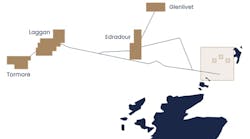Industry study to examine repurposing of older offshore facilities
There are many advantages in transitioning offshore facilities (platforms and pipelines) to alternative uses beyond traditional oil and gas when production becomes uneconomic. Continuing to use the facilities, or some part thereof, generates income, responsibly defers the eventual decommissioning and removal, and contributes to the clean energy transition. In addition to generating a new income stream, the new operations create employment, preserve important marine habitats, and have a positive environmental impact.
Endeavor Management’s Expert Advisory Group has been studying the feasibility of reusing old oil and gas platforms, both fixed and floating, for energy transition. Endeavor is now proposing a Joint Industry Project (JIP) to investigate key areas where collaborative solutions can be developed that benefit all. The focus will on the benefits, risks and uncertainties involved with converting an existing oil/gas platform, and where practical the pipelines, where production has ceased, to a range of clean energy uses. This JIP is focused on the offshore US Gulf of Mexico. However, the learnings should be of benefit to re-use of offshore facilities worldwide.
The transition away from traditional energy will present challenges and uncertainties for operators that will, in many cases, have a significantly different knowledge base compared to the offshore oil and gas industry. Additionally, rules and regulations that traditionally apply to the oil and gas industry may not be applicable, and the change in use of the platform may involve other regulations and agencies. There also will be scrutiny by industry, environmental groups, and other stakeholders who may feel impacted by the change of use and the uncertainties, real or perceived, that the change in use will bring.
Many options are available for re-use, including both renewable energy and some non-energy alternatives. Carbon capture, utilization and storage (CCUS), wind power, green hydrogen generation, geothermal power and ocean thermal energy conversion (OTEC) are some of the promising energy sector options. Aquaculture in various forms are being considered, as is the use of existing platforms for offshore/international security. In short, there are multiple technically feasible options, but all may not be commercially viable with current technology, market forces, government policy, and social expectations.
Understanding the value drivers, how to manage the risks of both the aging infrastructure and new technologies, and the new or additional rules and regulations will be crucial to making investment decisions and implementing projects responsibly. It will be important, therefore, to co-operatively create new frameworks and guidelines to manage these many challenges in a way that is agreed upon within this new offshore industry, and is understood by all stakeholders.
The overall strategy of the platform refurbishment JIP is to bring together operators plus other organizations with a vested interest in the emerging energy transition business. State and federal regulators plus other government agencies with a role in the activities in the Gulf of Mexico will be engaged in the scoping of this JIP, and encouraged to participate as their input is vital for all stakeholders. The final output from the JIP would be a set of roadmaps, best practices and guidance documents for operators and other stakeholders.
Some challenges to be faced in the transition are common to all re-use options, although they may differ in details, depending on the planned future use.
Understanding and being able to maintain structural integrity is vital. The offshore personnel, operator, investors, regulatory agencies, and the Gulf of Mexico community all need the highest level of assurance that people and the environment will not be harmed by failing structures. By its very nature, re-using offshore platforms involves the use of aging structures and infrastructure that have been subjected to the forces of nature and suffered environmental decay over many years. The key factors affecting integrity are well understood within the offshore energy and other maritime industries. All this knowledge needs to be used to manage the risks intelligently, determine how to assess current condition and predict future decay and, from there, develop effective ways of managing these aging structures. New technologies, including digitalization, will need to be an important part of the smart integrity management strategy. Corrosion control technology for both above and below water are well advanced, making long-term corrosion protection easily achievable. Fatigue, particularly of welded joints, commonly is considered a greater concern, but need not be. Computer modeling can focus inspections on safety critical joints and, if necessary, these joints could be strengthened to remove the concern of fatigue failure.
The change of use and the understandable concerns of continuing to use aging platforms needs to be managed intelligently with the regulatory organizations responsible for safe operations. How the new industries are going to operate safely without risk to people and the environment needs to be presented carefully and logically. This would need to include the immediate impacts of the change of use and, more importantly, how safety and protecting the environment is going to be managed and maintained in the long term.
Environmental, social, and (corporate) governance (ESG) is likely to be a factor in investment decisions and in gaining the acceptance by the community, making studying the environmental and sustainability concerns associated with the transition process and future operations a key factor. Consideration may need to be given to assessing the benefits to marine life and others, such as sports fishermen, of preserving the habitats already created by the offshore structures. Other benefits to be understood and quantified could include assessing the greenhouse gas emissions reductions from the proposed use of existing assets and emission savings achieved if a facility was not removed.
All the options for re-use present their own unique challenges, making some potentially more realistic than others. Business drivers, technology limits, local and federal regulations, and the needs and desires of the greater GoM community will all play an important part in the feasibility of the future of the ageing platforms.
A major challenge for hydrogen is its incompatibility with existing steel pipelines and associated fittings and equipment, hence requiring new pipelines, major retrofits or other transport means. The fundamental concern is that pumping pure hydrogen into existing oil and gas transport and storage systems will lead to hydrogen embrittlement failures. Blending limited amounts of hydrogen into natural gas is allowable to provide some transportability using existing pipelines. By current accepted practice, the limit is no more than 20% hydrogen mixed with natural gas. There are technologies available to internally line existing pipelines with hydrogen-tolerant materials, which may be a solution. The approach being taken by one development in the North Sea is to boost the naturally declining gas production by producing hydrogen by electrolysis of seawater and adding that to the produced natural gas. Key to the viability of this project is the availability of green electricity from onshore wind farms. In this case, the green power is already being transmitted via a subsea cable previously installed to electrify the platform, to eliminate carbon emissions from the traditional generators and compressors. For the future of this North Sea project, as hydrogen production is increased, deepwater offshore wind power is being considered to provide the electricity for electrolysis.
Pumping CO2 though existing pipelines to offshore platforms for capture and storage in suitable depleted wells is possible provided that the gas is treated to prevent internal corrosion in the pipeline. The logical option would be to dry the gas sufficiently so that corrosion cannot occur. Corrosion inhibitor treatment could also be feasible but that may have its own challenges. Re-pressurization of the gas at the platform for injection into the well may be needed and doing that using clean energy will need consideration. For near-shore platforms, it may be practical to install a subsea electrical supply from onshore green energy.
To date, offshore wind developments worldwide indicate that large numbers of turbines are needed for economic viability, so it seems unlikely that installing a single wind turbine on an existing platform would be sufficient for producing power for onshore use. There may be other options such as generating limited amounts of wind power from a turbine on a fixed platform to electrify other nearby operating oil and gas operations to reduce their carbon emissions or using the fixed platform for the offshore sub-station as part of a larger wind farm. There are some in the industry who doubt the practicality of offshore wind in the Gulf of Mexico because the GoM has lower wind profiles than other areas and because of possible cyclonic wind damage.
With all the options, it lies with the experts, operators, regulators and the Gulf of Mexico community to decide if a new lease on life for the aging oil and platforms is preferable to their removal. Some could, as has already happened, become artificial reefs, which provide important coastal protection and marine life habitats. Others would need to be removed and brought onshore for safe disposal. Keeping the platforms where they are and making alternative use from them preserves the marine habitats that have already developed around them; maintains and creates new employment and businesses; and contributes to environmental improvement. Technically, the reuse of aging platforms is feasible if managed correctly, but there may need to be some adjustment in regulations to allow this to happen while maintaining safety and protection of the environment. As for the benefits, all stakeholders will have to decide.
The author
Brian Gibbs an integrity management and risk specialist with Endeavor Management. His work experiences span the entire asset life cycle including concept/feasibility design studies; risk assessments; incident investigations, capital project verification; in-service inspection and integrity management; aging facility life extension. This has included being the technical authority for a range of offshore aging infrastructure projects. These projects have included life extension of FPSOs and TLPs, corrosion management of floating facilities and regulatory compliance. Gibbs has provided inspection, certification, risk management and integrity management consulting services to a wide range of asset owners and operators. He has also worked collaboratively with industry specialists to provide tailor-made safe and effective solutions to a range of situations.



